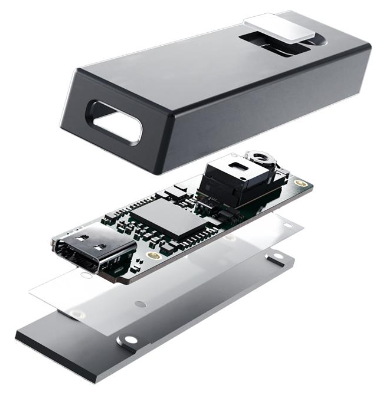pmd – yes, they do seem to like a lower-case styling – recently released a plug-in-and-play depth-sensing development kit for their flexx2 3D depth camera, which features pmd’s latest Time-of-Flight image sensor with 38k 3D pixels (HQVGA 224 x 172 resolution), 56° x 44° Field-of-View, and an upgraded VCSEL emitter (850 nm to 940 nm wavelength) for precise depth measurements from 10 cm up to 4 meters at up to 60 fps; that’s a whopping 2.3 million 3D data points per second!
With flexible working ranges and frame rates, the kit is the perfect tool for developers who want to be ahead of their time, and once a design engineer has evaluated the technology, an OEM version of the flexx2, without the casing, is available for end-product integration. That said, it is worth noting that while the kit has extensive certification, including CE, RoHS, and Eyesafety IEC60825-1:2014 Laserclass 1, the OEM version does not, and all certification must be done by the end-device engineering team.
The flexx2 builds on the success of pmd’s now-discontinued ‘PicoFlexx’, which already brought 3D depth-sensing technology to the hands of thousands of developers worldwide, and even to space. The technology can be used for many 3D image sensing applications, from simple distance measurement to object detection or precise gesture control, all enabled in a 71.9 x 19.2 x 10.6 mm device with a new, more robust USB 3.0 Type-C port, multiple built-in user modes, and a power consumption of 570 – 680 mW. An updated software development kit, ‘Royale’, and API support the development of countless exciting and industry-changing projects, with sensing accuracy ≤1% of distance (0.5 – 4 m @ 5 fps) or ≤2% of distance (0.1 – 1m @ 45 fps) enabled by the IRS2381C Infineon® REAL3™ 3D Image Sensor at the heart of the device.
We all know that the human eye and computer algorithms can be easily fooled by patterns, perspectives, and movements, but with pmd’s IR vision being independent of external light, 3D depth sensing need no longer be an issue in visually noisy environments. Even at 100K Lumens (full sunlight), there is only a loss of 10% of the maximum range outdoors when compared to indoors, which judging by pmd’s proud boast of the feature, I would assume is a big issue in conventional LiDAR imaging. While the range of 4 m seems too short for long-range automotive sensing – perhaps I am ignorant – pmd offers a few other 3D depth sensing solutions and cite ‘vehicles’ as one of their key application markets. I suppose these devices would be perfect for parking sensors, but I think they would also work very well in small cleaning or lawn-mowing robots or 3D scanners.
Keep designing!
Edit: After chatting with pmd, they revealed that the automotive applications for this device are based around in-cabin monitoring for safer deployment of airbags depending on the passenger. Additionally, sunlight resilience is indeed one of the key selling points of this device as many Lidar systems suffer in this regard.
(Image sourced from pmd technologies)

